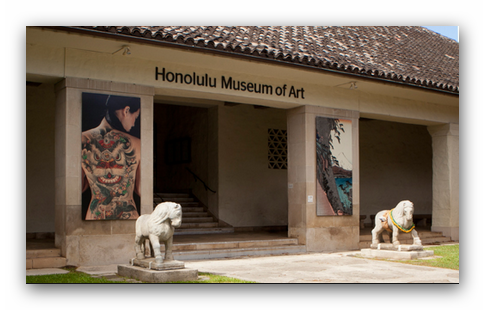Aug 24 2017 - Oct 22 2017
Honolulu, HI
Born in Ibaraki Prefecture, Maejima Tadaaki, also known as Maki Haku (1924–2000), was one of the most internationally prominent members of the Creative Print (sōsaku hanga) movement, which emphasized the need for Japanese print artists to create their own works without relying upon specialists such as woodblock carvers, as designers of ukiyo-e prints traditionally did throughout the Edo period (1615–1868).
During the Pacific War (1941–1945), Maejima was enlisted in the Japanese Air Force as a kamikaze pilot, but the war ended before he was assigned a suicide mission. In the late 1950s, he began to produce prints and assumed the pseudonym Maki Haku (literally, “white roll,” with connotations similar to “airhead”) to promote himself as an eccentric artist who lacked academic training.
Maki Haku’s embossed compositions, featuring either a stylized Chinese character or a quintessentially Japanese symbol such as a persimmon, caught the attention of art patrons throughout the world, including the Honolulu-based author Oliver Statler (1915–2002). In 1967, Maki represented Japan in the Venice Biennale. See the evolution of his style in this selection of works from throughout his career.
Credit: Exhibition overview from museum website
Whether you go or not, The Life and Works of Haku Maki surveys the man and his work. A highly innovative printmaker of the second half of the 20th century, his prints often had a three-dimensional quality, derived from the embossing which Maki used in much of his work. To obtain the embossed effect, Maki used wet cement into which he carved the basic design for a print. After the design settled and was carved, Maki used double-layered paper, raising the subject from the surface of the paper. Maki's oeuvre is characterized by clean, sharp images, whether done in black kanji on a white background or in a bright color against a dark background. His prints usually contain one outstanding object, whether kanji or a ceramic vessel or a persimmon.
Maki's prints invariably have a modern look and feel to them; they fit in the early 21st century just as well as they did when they were first produced 20-30 years ago. Yet Maki's primary subjects are very traditional. His achievement was to rework and update the traditional, producing an image that delights and sometimes surprises the viewer as the old emerges, recognizable but new. With little fuss and few frills, Maki allows the viewer to concentrate on the core subject and nothing else. Very Zen.
Click to place The Life and Works of Haku Maki in your Amazon shopping cart.
Exhibition Venues & Dates
Aug 24 2017 - Oct 22 2017
Honolulu, HI

